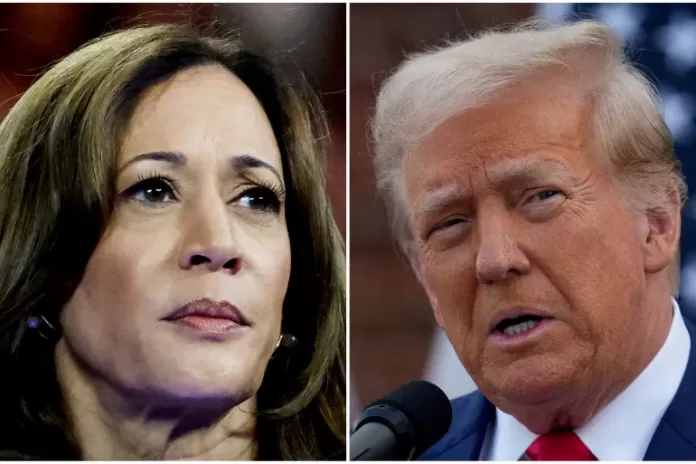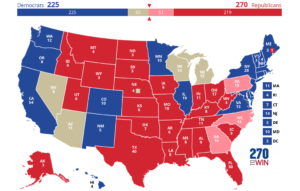On November 5, 2024, millions of Americans will flock to the polls to make their voices heard in a consequential presidential election, pitting Democratic candidate Kamala Harris against Republican incumbent Donald Trump. With less than 48 hours remaining before polling stations close, the race is intensifying, marked by sharply contrasting visions for the future of the nation.
Recent polling reveals that Kamala Harris holds a marginal lead over Donald Trump in several key swing states. As of now, more than 77.6 million votes have already been cast, with Harris leading early voters by 8%. However, Trump is ahead among those who express strong intentions to vote but have not yet done so.
According to a poll conducted by the New York Times and Siena College, Harris is slightly leading in three pivotal swing states, while Trump holds an advantage in one state, and the other three remain too close to call.
In the final hours leading up to the election, both candidates are ramping up their campaigning efforts, particularly in battleground states like Pennsylvania and Michigan, where polls indicate a neck-and-neck race.
Harris is currently in Michigan, focusing her message on infrastructure and economic revitalization, while Trump held a rally in Pennsylvania. At this event, he controversially remarked on his safety, suggesting that if there were another assassination attempt against him, someone would have to shoot through the “fake news,” whom he accused of being “seriously corrupt.”
The electoral landscape is complex, governed by a system established by the U.S. Constitution, where each state conducts its own voting process. The candidates are vying for a total of 538 electoral votes, with 270 needed to secure the presidency.
Most states operate on a winner-take-all basis, awarding all electoral votes to the candidate who wins the popular vote. This makes swing states—historically alternating between Democratic and Republican candidates—crucial battlegrounds that could determine the election outcome.
Pennsylvania
Pennsylvania, with its 19 electoral votes, is a state that has seen shifting allegiances. Once a reliable Democratic stronghold, it has become increasingly competitive. Trump narrowly won Pennsylvania in 2016 by just 0.7 percentage points, while Biden reclaimed it in 2020 with a margin of 1.2 points.
Both candidates have been actively campaigning in the state, particularly in its key cities like Philadelphia and Pittsburgh, where the decline of the industrial base has left many residents concerned about their economic future. Harris is emphasizing recent infrastructure investments, promising $100 billion to boost manufacturing in the state, while Trump is courting rural voters with warnings about immigration impacting small towns.
Georgia
In Georgia, another critical battleground with 16 electoral votes, the aftermath of the 2020 election remains a hot topic. Trump faces ongoing legal challenges related to his efforts to overturn Biden’s narrow victory in the state, yet recent polling suggests demographic changes could favor Harris. Since Biden’s win in 2020—the first for a Democrat since 1992—Harris has been actively engaging with minority communities, which may play a crucial role in the state’s outcome.
North Carolina
North Carolina, with 16 electoral votes, has historically leaned Republican but is experiencing a demographic shift that Harris hopes to capitalize on. The state has only voted Democratic once since 1980, yet recent growth in diverse populations could provide an opportunity for the Democrats. Complicating matters for Trump is a scandal involving the state’s Republican gubernatorial candidate, which could hinder his campaign in this closely contested race. The recent devastation from Hurricane Helene may also influence voter sentiment and turnout in affected areas.
Michigan
In Michigan, Trump flipped the state in 2016 but lost it to Biden in 2020, aided by strong support from unionized workers and Black voters. Harris now faces potential challenges from the Arab-American community, who have expressed dissatisfaction with Biden’s handling of the Israel-Hamas conflict. This demographic could sway the election, making Michigan a critical focus for both candidates.
Arizona
Arizona, another key battleground with 11 electoral votes, was one of the closest races in 2020, with Biden winning by just 10,457 votes. Trump is seeking to reclaim the state by focusing on frustrations surrounding the Biden-Harris administration’s immigration policies. In September, Harris visited the border to address these concerns, highlighting her commitment to reforming immigration and resurrecting a bipartisan border bill that Trump has been accused of undermining.
Wisconsin
In Wisconsin, with 10 electoral votes, the race has tightened significantly. Trump had initially gained an early lead against Biden in 2020, but Harris has made it competitive again. The Republican National Committee held its summer national convention in Wisconsin, indicating the state’s importance to their campaign strategy. Both candidates are keenly aware that turnout in suburban areas, particularly those outside of Milwaukee, could tip the scales.
Nevada
Lastly, Nevada, with 6 electoral votes, has not voted Republican since 2004. Trump’s team has been encouraged by his efforts to connect with Hispanic voters, but Harris has worked hard to erase Trump’s prior advantage by promoting economic initiatives aimed at small businesses and tackling inflation, particularly in Las Vegas, a city dominated by the hospitality industry.
As Election Day approaches, uncertainty looms over the timing of the results. The current political climate suggests that the announcement of a winner could take longer than usual. In 2020, results were drawn out over several days, with states like North Carolina and Georgia still counting votes well after the polls closed. This year, the tightness of the race across the swing states further complicates predictions.
With concerns about potential unrest on Election Day, Trump has been vocal in questioning the integrity of the election, claiming he could only lose if there were widespread cheating.
This rhetoric has raised alarms about possible violence, reminiscent of the January 6 Capitol riots. Law enforcement is on alert, with police preparing for possible disruptions in several cities. The Republican National Committee plans to deploy thousands of poll monitors, which critics fear could lead to harassment of voters and election workers.
The outcome of this election will be closely watched not only for its immediate implications but also for its historical significance. With a deeply divided electorate, the 2024 election represents a crucial moment for the United States.
As voters prepare to cast their ballots, the nation stands at a crossroads, poised to either continue down the path established by the Trump administration or shift toward Harris’s vision for the future. As both candidates make their final appeals, the eyes of the country are fixed on the polls, where the decision will ultimately be made.


